- Teeth start to form even before birth. Milk teeth, or baby teeth, start to form when a baby is in the womb, but teeth don’t begin to show until a child is between six and twelve months old.
- No two people have the same set of teeth—your teeth are as unique as your fingerprint, so be proud of your unique set of teeth.
- Say Cheese! The calcium and phosphorus found in cheese is healthy or your teeth – it reduces the pH level in plaque and re-mineralizes the enamel.
- The average human produces 25,000 quarts of saliva in a lifetime. That is enough saliva to fill 2 swimming pools!
- Dogs have 42 teeth, cats have 30 teeth, pigs have 44 teeth, and an armadillo has 104 teeth.
- Many diseases are linked to your oral health, including heart disease, osteoporosis, and diabetes.
- The plaque found in your teeth is home to more than 300 different species of bacteria. Listerine, anyone?
- In Medieval Germany, the only cure for a toothache was to kiss a donkey.
- The average woman smiles about 62 times per day! A man? Only 8.
- 50% of people surveyed say that a person’s smile is the first physical trait they notice.
- U.S. and Japanese studies have found that black or green tea has antibacterial powers that help prevent cavities and gum disease.
- In Vermont, it is illegal for women to wear false teeth without the written permission of their husband.
- On September 20th, China celebrates “Love your Teeth Day” – a national holiday promoting oral awareness among its 1.2 billion people.
- A long time ago, humans utilized charcoal or ground up chalk, ashes, lemon juice, and honey-tobacco mixture to clean their teeth. It was only around a hundred years ago that the toothpaste was invented.
- In the 1800s, people who had false teeth in England ate in their bedrooms before gatherings and events at the dinner table. This unique Victorian tradition protected them against the embarrassment of having their teeth ‘fall off’ while dining.
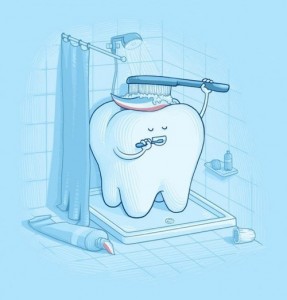
Fun Teeth Facts
July 11, 2014
Alternatives to Tooth Extraction
July 3, 2014
If you have a damaged or diseased tooth, extraction is not the only option. When possible, it is always best to save your teeth rather than lose them. Missing teeth may have negative effects on confidence, ability to chew, general health and oral health and the alignment of the remaining teeth. Consider the following treatment options before opting for an extraction.
Root Canal:
Root canal remains the most popular alternative to extraction. A root canal procedure is performed when the nerve of the tooth becomes infected or the pulp becomes damaged. During a root canal procedure, the nerve and pulp are removed, and the inside of the tooth is cleaned and sealed.
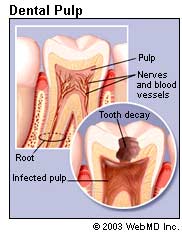
Dental Implants:
A dental implant is an artificial tooth root that is placed into your jaw to hold a replacement tooth or bridge. Dental implants may be an option for people who have lost a tooth or teeth due to periodontal disease, an injury, or some other reason. The implant emulates the shape of the root and is usually made of titanium and other materials that are well-suited to the human body. The implant is surgically placed into the jaw and incorporates into the bone over time to become a stable base for crowns. Dental implants have been used for several decades by patients of all ages. They can replace a single tooth, several teeth or support partial or full dentures.
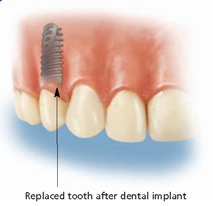
Apicoectomy:
An apicoectomy, or root-end resection, which is occasionally needed when inflammation or infection persists in the bony area around the end of your tooth after a root canal procedure can also be performed to save a tooth. In this microsurgical procedure, the dentist opens the gum tissue near the tooth to see the underlying bone and to remove any inflamed or infected tissue. The very end of the root is also removed. A small filling may be placed to seal the end of the root canal and few stitches or sutures are placed to help the tissue heal. Over a period of months, the bone heals around the end of the root. Local anesthetics make the procedure comfortable, and most patients return to their normal activities the next day. Postsurgical discomfort is generally mild.
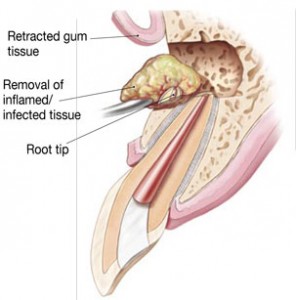
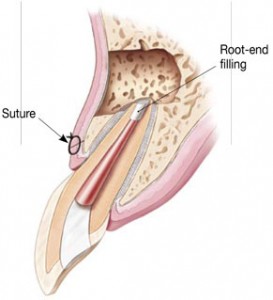
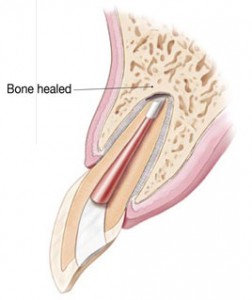
Are there any other options?
For replacement of an extracted tooth, you may also consider a bridge or removable partial denture. These options require additional dental procedures on adjacent healthy teeth, and should be discussed with your dentist or specialist. Check with our office to discuss any concerns or if you just want more information.
